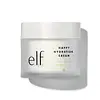What's inside
What's inside
 Key Ingredients
Key Ingredients

No key ingredients
 Benefits
Benefits

 Concerns
Concerns

 Ingredients Side-by-side
Ingredients Side-by-side

Water
Skin ConditioningCannabis Sativa Seed Oil
EmollientStearyl Heptanoate
EmollientIsohexadecane
EmollientGlycerin
HumectantButylene Glycol
HumectantNiacinamide
SmoothingIsopropyl Isostearate
EmollientCetearyl Olivate
Trehalose
HumectantStearic Acid
CleansingAluminum Starch Octenylsuccinate
AbsorbentPolymethylsilsesquioxane
Silica
AbrasiveSodium Hyaluronate
HumectantPalmitoyl Tripeptide-1
Skin ConditioningPalmitoyl Tetrapeptide-7
Skin ConditioningPanthenol
Skin ConditioningSorbitan Olivate
EmulsifyingCetearyl Alcohol
EmollientGlyceryl Stearate
EmollientPEG-100 Stearate
Polyethylene
AbrasiveDisodium EDTA
Polyacrylate-13
Polyisobutene
Polysorbate 20
EmulsifyingCaprylyl Glycol
EmollientPhenoxyethanol
PreservativeEthylhexylglycerin
Skin ConditioningCarbomer
Emulsion StabilisingBHT
AntioxidantWater, Cannabis Sativa Seed Oil, Stearyl Heptanoate, Isohexadecane, Glycerin, Butylene Glycol, Niacinamide, Isopropyl Isostearate, Cetearyl Olivate, Trehalose, Stearic Acid, Aluminum Starch Octenylsuccinate, Polymethylsilsesquioxane, Silica, Sodium Hyaluronate, Palmitoyl Tripeptide-1, Palmitoyl Tetrapeptide-7, Panthenol, Sorbitan Olivate, Cetearyl Alcohol, Glyceryl Stearate, PEG-100 Stearate, Polyethylene, Disodium EDTA, Polyacrylate-13, Polyisobutene, Polysorbate 20, Caprylyl Glycol, Phenoxyethanol, Ethylhexylglycerin, Carbomer, BHT
 Reviews
Reviews

Ingredients Explained
These ingredients are found in both products.
Ingredients higher up in an ingredient list are typically present in a larger amount.
Ethylhexylglycerin (we can't pronounce this either) is commonly used as a preservative and skin softener. It is derived from glyceryl.
You might see Ethylhexylglycerin often paired with other preservatives such as phenoxyethanol. Ethylhexylglycerin has been found to increase the effectiveness of these other preservatives.
Glycerin is already naturally found in your skin. It helps moisturize and protect your skin.
A study from 2016 found glycerin to be more effective as a humectant than AHAs and hyaluronic acid.
As a humectant, it helps the skin stay hydrated by pulling moisture to your skin. The low molecular weight of glycerin allows it to pull moisture into the deeper layers of your skin.
Hydrated skin improves your skin barrier; Your skin barrier helps protect against irritants and bacteria.
Glycerin has also been found to have antimicrobial and antiviral properties. Due to these properties, glycerin is often used in wound and burn treatments.
In cosmetics, glycerin is usually derived from plants such as soybean or palm. However, it can also be sourced from animals, such as tallow or animal fat.
This ingredient is organic, colorless, odorless, and non-toxic.
Glycerin is the name for this ingredient in American English. British English uses Glycerol/Glycerine.
Learn more about GlycerinPhenoxyethanol is a preservative that has germicide, antimicrobial, and aromatic properties. Studies show that phenoxyethanol can prevent microbial growth. By itself, it has a scent that is similar to that of a rose.
It's often used in formulations along with Caprylyl Glycol to preserve the shelf life of products.
Water. It's the most common cosmetic ingredient of all. You'll usually see it at the top of ingredient lists, meaning that it makes up the largest part of the product.
So why is it so popular? Water most often acts as a solvent - this means that it helps dissolve other ingredients into the formulation.
You'll also recognize water as that liquid we all need to stay alive. If you see this, drink a glass of water. Stay hydrated!
Learn more about Water